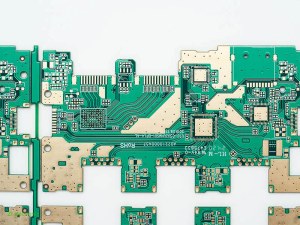ZF Electronics, as one of the top circuit board factory in China, can provide customers with single-sided PCB, double-sided FR4 PCB, metal core PCB, heavy copper PCB, rigid PCB and rigid-flex PCB. It provide pcb board, single layer pcb, multi layer board, rigid flex pcb, aluminum pcb,etc.
It is well known that the base material (polymer or glass) is changing from a glassy, solid, rigid state to a rubbery state when the temperature rises to a specific value, hence the temperature at this point is called the glass transition temperature (Tg). That being said, tg in pcb is the mechanical property that specifies the glass transition temperature, which is the maximum temperature at which the glass will remain rigid. In other words, ordinary PCB substrates will not only soften, deform, and melt at pcb high tg, but their mechanical and electrical properties will also deteriorate dramatically, affecting the service life of the product.
Normal PCBFR4-Tg is 130-140℃, middle Tg is higher than 150-160 ℃, and high Tg is higher than 170 ℃. High FR4-Tg provides better mechanical and chemical resistance to heat and moisture than standard FR4. The higher the pcb tg value, the better the heat resistance and moisture resistance of the tg170 pcb material, therefore, especially in lead-free process, the high temperature pcb.
Performance of high Tg PCBs
With the rapid development of the electronics industry, high Tg materials are widely used in computers, communication equipment, precision instruments, and instrumentation. In order to achieve highly functional, multilayer development, PCB substrate materials are required to be more heat resistant. Furthermore, due to the emergence and development of high-density mounting technology represented by SMT and CMT, PCBs are increasingly inseparable from the substrate heat resistance in terms of small aperture, fine circuit and being thinner. Therefore, the differences between normal FR4 and high FR4-Tg lie in mechanical strength, adhesion, water absorption, dimensional stability, thermal decomposition in the thermal state (especially after water absorption) under different conditions (for example, thermal expansion). It is evident that high Tg PCBs are better than ordinary PCB substrate materials. As a result, the demand of high Tg PCBs has been growing in in recent years, but it is more expensive than standard PCBs. Now the tg113 circuit board price is very reasonable.
What's more, high Tg materials are also popular in the LED lighting industry because LEDs have a higher dissipation rate than ordinary electronic components, but the same construction of FR4 PCBs is much cheaper than metal-core PCBs such as aluminium-core PCBs.
The advantages of high Tg PCB
1. Higher stability
If the Tg of the PCB substrate is increased, it will automatically improve the heat resistance, chemical resistance, humidity resistance, and device stability.
2. Withstand high power density designs
If the device has a high power density and fairly high heat generation, then a high Tg PCB would be an excellent solution for heat management.
When reducing heat generation from ordinary boards, larger printed circuit boards can be used to change the design and power requirements of the equipment, and high Tg PCBs can also be adopted.
3. Ideal choice for multilayers and HDI PCBs
As multilayer PCB and HDI PCB are more compact and have dense circuit, more heat dissipation will be generated. Therefore, high Tg PCBs are often used for multilayers and HDI PCBs to ensure PCB manufacturing reliability.
When do we need a high Tg PCB?
If your PCB cannot withstand a thermal load of any less than Tg 25℃, your application will require a high Tg PCB. In addition, if your product operates in the temperature range of 130 ℃ or higher, it can ensure the safety of using high Tg PCBs. The main reason for the high Tg PCB is to switch to RoHS PCB. Thus, more and more PCB industries are turning to use high Tg materials, as higher temperatures are required for lead-free solder.
High Tg PCB application areas
The high Tg PCB will be the best solution if the power density in the electronics is higher, and the heat generation interferes with the heat sink or other parts of the product. Besides, with the popularity of high Tg PCBs in recent years, you will find Tg PCBs being used in the electronics industry, where they can operate at higher temperature. Therefore, we meet the needs of our customers in different industries by offering high Tg PCBs with high heat resistance that meet customer specifications in a short lead time.
Our high Tg PCB can be used in gateways, RFID, inverters, antenna boards, wireless boosters, contract manufacturing services, low-cost PLCs, embedded system development, embedded computer systems, AC power supplies.
If you have questions about our high Tg PCB production capacity, or the specifications required for your custom project are not listed on this page, please feel free to contact us. We will reply within one workday. We will continue to provide quotation support and design support. Welcome to learn about our production process.
Location : 810 Shang Xing Buliding, Shajing Town, Bao'an District, Shenzhen, China,, 518105 Shenzhen,
Contact : He Mike, +86 188 7956 1688











